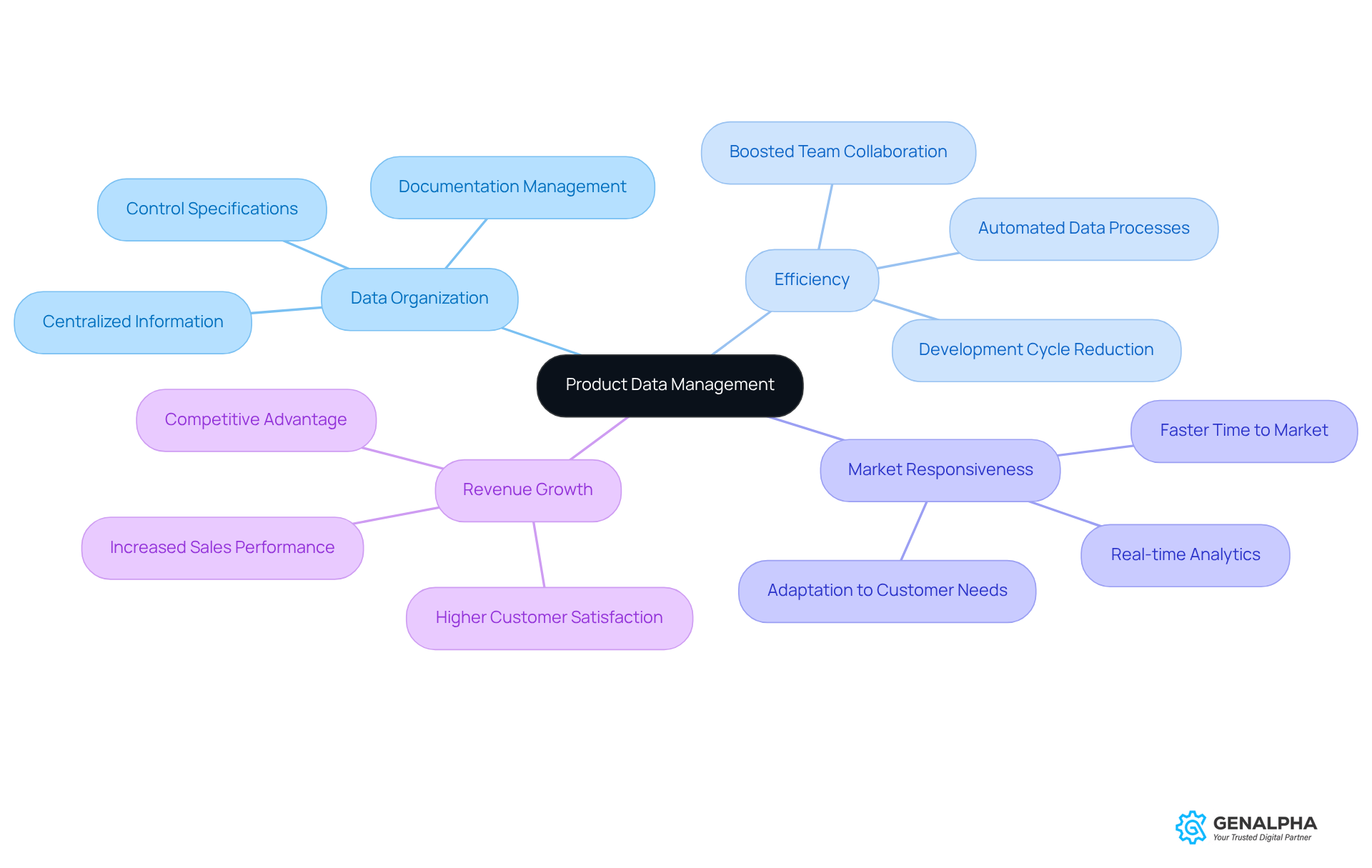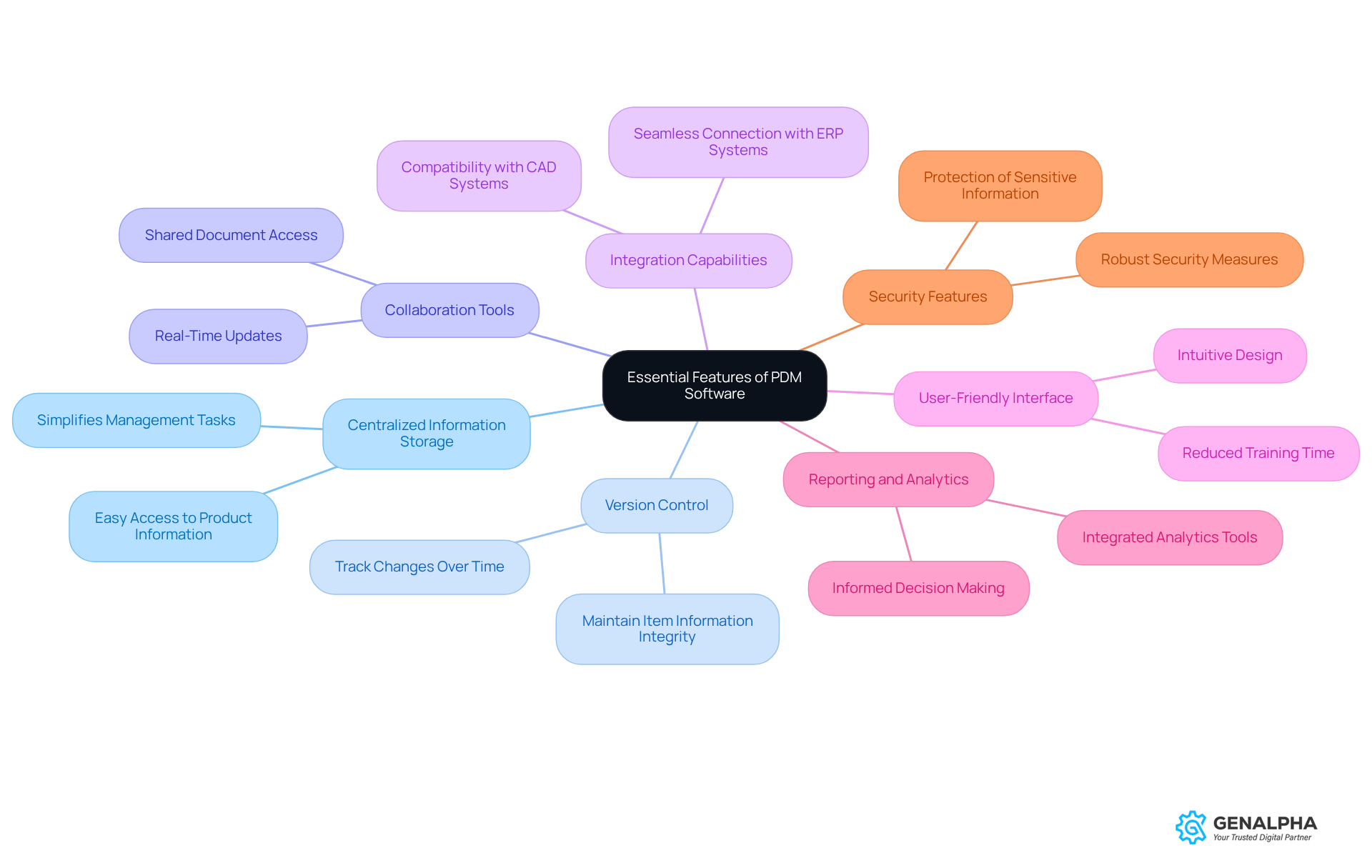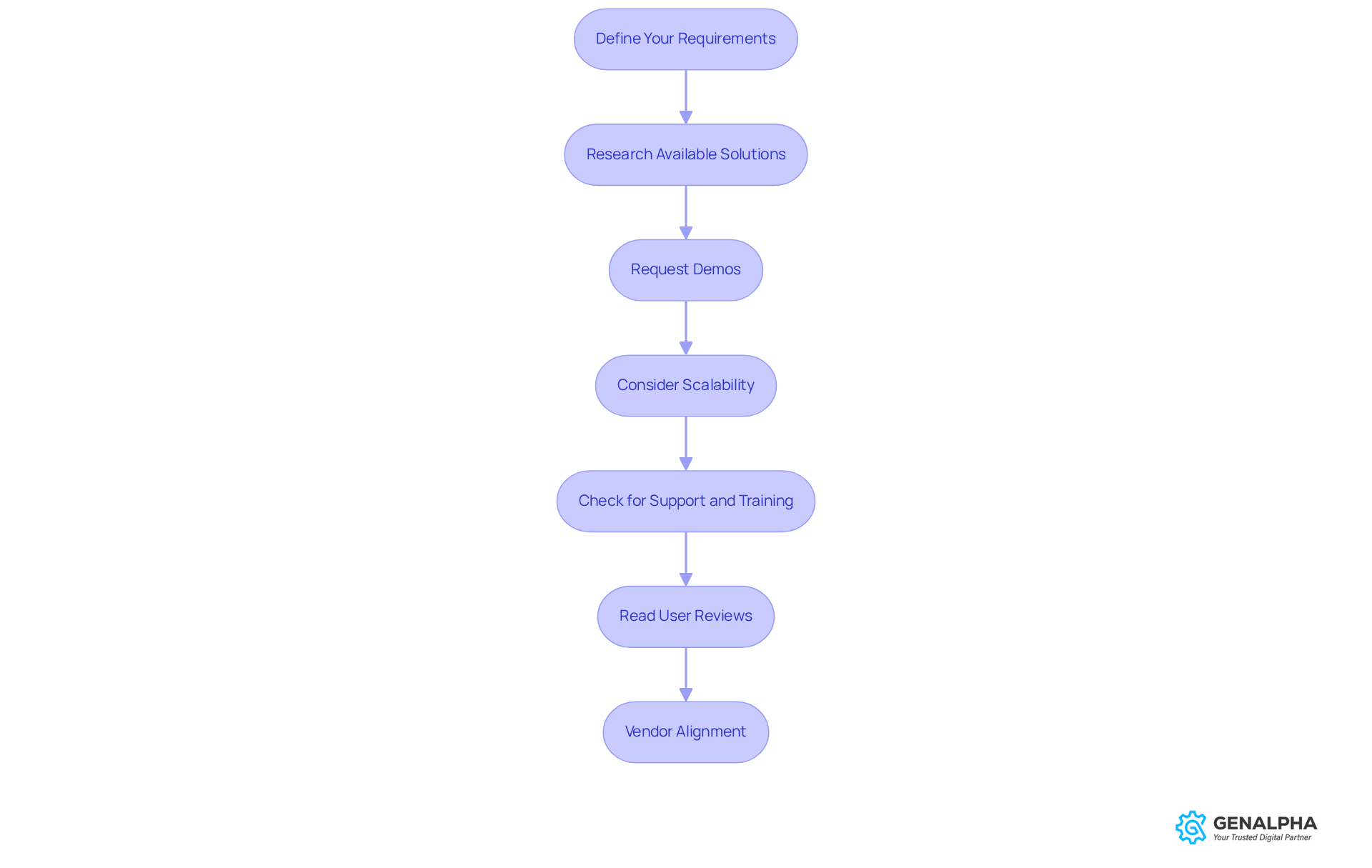Overview
Have you ever felt overwhelmed by managing product data? You're not alone! In this article, we explore a straightforward four-step process to master product data management (PDM) software. Why is this important? Because effective data handling can really boost your operational efficiency and help you respond to the market faster.
Let’s dive into the essential features of PDM software. We’ll also discuss how to evaluate these tools based on your business needs and share some implementation strategies. By taking a systematic approach, you can see significant improvements in product management and overall business performance.
So, are you ready to transform your product data management? Let’s get started together!
Introduction
Product data management (PDM) has become a vital cornerstone for businesses looking to stay competitive in today’s data-driven marketplace. By effectively organizing and controlling product-related information, companies can:
- Streamline operations
- Enhance collaboration
- Significantly reduce time-to-market
But as organizations dive into the complexities of selecting and implementing the right PDM software, they often hit roadblocks that can slow them down.
So, how can businesses ensure they not only choose the best PDM solution but also implement it effectively to reap all the benefits?
This guide offers a clear, step-by-step approach to mastering product data management software, empowering you to optimize your workflows and drive growth.
Understand Product Data Management and Its Importance
Have you ever thought about how much product-related data we juggle every day? Product data management software is focused on systematically handling that data throughout its lifecycle. This includes organizing, storing, and controlling specifications, CAD files, and documentation. By centralizing item information, we create a single source of truth—no more inconsistencies or mistakes that slow us down!
This approach really boosts teamwork and helps us get products to market faster while enhancing the overall quality of what we offer. In today’s world, where customer expectations are always on the rise, effective product data management software isn’t just a nice-to-have; it’s essential for manufacturers and distributors who want to optimize their operations and respond quickly to market demands.
For instance, companies that have embraced strong product data management software often see a significant increase in efficiency and a reduction in development cycles. That’s a win-win! Plus, experts suggest that organizations with robust PDM capabilities can achieve up to 20% greater revenue growth compared to their competitors. This really highlights why investing in efficient product information management solutions is a smart move. So, are you ready to take your PDM to the next level?

Identify Essential Features of PDM Software
When you're on the hunt for PDM software, there are a few key features you definitely want to keep in mind:
- Centralized Information Storage: Imagine having all your product-related information in one easy-to-access spot. A solid PDM system should make this a reality, simplifying your management tasks.
- Version Control: Ever worried about losing track of changes? Efficient version management is your best friend here, helping you monitor alterations and keep your item information intact over time.
- Collaboration Tools: Look for features that make teamwork a breeze. Think shared document access and real-time updates that keep everyone in the loop.
- Integration Capabilities: Your PDM should play well with others, seamlessly connecting with your existing ERP and CAD systems to streamline your workflows.
- User-Friendly Interface: Nobody wants to spend ages figuring out software. A simple, intuitive interface boosts user adoption and cuts down on training time.
- Reporting and Analytics: Integrated analytics tools can provide valuable insights into performance and data usage, helping you make informed decisions.
- Security Features: Last but not least, ensure your application has robust security measures to keep sensitive item information safe.
So, as you dive into evaluating PDM software, keep these features in mind. They can make a significant difference in how smoothly your operations run!

Evaluate PDM Software Options Based on Business Needs
To effectively evaluate PDM software options, let’s walk through some simple steps together:
-
Define Your Requirements: Start by identifying what your organization truly needs. Think about the types of products you manage, the volume of data, and how many users will be involved. This foundational step is crucial—did you know that 70% of success in PDM implementation hinges on aligning around culture, processes, and communication?
-
Research available solutions: Explore product data management software applications that fit your defined requirements. Check out application reviews and comparison websites to gather detailed information. For instance, companies like Nike conduct quarterly audits to keep their product information up-to-date, showcasing the importance of thorough research and ongoing evaluation of PDM systems.
-
Request Demos: Set up presentations with selected vendors to see their applications in action. This hands-on experience is key, as 30% of PDM implementation success can be linked to how user-friendly the system is.
-
Consider Scalability: Make sure the system can grow alongside your business. Assess its ability to handle increased data volume and additional users as your organization expands. Flexibility in product data management software choices is essential for long-term success, as businesses need to adapt their systems over time. Plus, think about whether you might need a Product Life-cycle Management (PLM) system in the future to meet evolving business demands.
-
Check for Support and Training: Look into the level of customer support and training the vendor offers to help make your implementation process as smooth as possible. Reliable and responsive customer support is vital for getting the most out of your PDM investment.
-
Read User Reviews: Don’t forget to seek feedback from current users! Their insights into the strengths and weaknesses of each application can help you dodge potential pitfalls and make a more informed decision.
-
Vendor Alignment: Aim for at least 80% alignment with your chosen vendor or integrator. This level of alignment is recommended for a successful PDM implementation and can significantly enhance how well the system meets your business needs.
By following these steps, manufacturers can ensure they select a PDM solution that not only meets their current needs but also supports future growth and operational efficiency. And hey, consider checking out the "PDM Evaluation Framework" from Tech-Clarity to guide your evaluation process!

Implement the Chosen PDM Software Effectively
To implement your chosen PDM software effectively, let’s break it down into some friendly steps:
-
Assemble a Cross-Functional Team: Start by gathering a diverse group from various departments—think IT, engineering, product management, and more. Why? Because this collaboration ensures all perspectives are considered, making for a smoother transition. Remember, as KETIV highlights, every company is unique, and so are your information management needs.
-
Map Current Processes: Next, document your existing workflows and information management practices. This helps pinpoint inefficiencies and areas that could use a little TLC. By analyzing these processes, you lay the groundwork for a successful transition to the new system, tailored to your organization’s specific needs.
-
Set Clear Objectives: Now, let’s define some specific goals for your PDM implementation. Whether it’s reducing data retrieval times or boosting collaboration across departments, clear objectives will guide your team and provide measurable benchmarks for success. Fun fact: by 2027, over 70% of industrial manufacturers are expected to rely on digital twins to enhance product reliability and lifecycle services. This really underscores how crucial effective product data management software implementation is in today’s competitive landscape.
-
Conduct Training Sessions: Don’t forget to provide comprehensive training for all users! Ensuring everyone understands how to use the new system is key to fostering user adoption and minimizing resistance to change. Adequate training empowers your team, helping them contribute effectively to your company’s success.
-
Monitor Progress: After going live, it’s important to regularly assess how the system is performing against your defined objectives. Gather user feedback to identify any challenges and areas that could use some improvement. KETIV reminds us to anticipate that issues may arise post-implementation, so having a support plan in place is wise.
-
Iterate and Improve: Finally, keep refining your processes and features based on user input and evolving business needs. This iterative approach maximizes the value of product data management software and ensures it stays aligned with your organizational goals. For instance, take a look at Boeing’s use of PDM to unify design and engineering data—it’s a great example of how assembling cross-functional teams can lead to success in PDM implementation.
So, are you ready to get started? Let’s make this transition as smooth as possible!

Conclusion
Mastering product data management software is crucial for any organization looking to boost efficiency and stay ahead of the competition. Have you ever thought about how important product data management really is? By understanding its significance and pinpointing the key features of the right software, businesses can streamline operations and enhance product quality. Evaluating options based on specific business needs and implementing chosen solutions effectively can make a world of difference.
This article has highlighted the importance of:
- Centralizing product information
- Using version control
- Fostering collaboration
- Ensuring integration capabilities
It’s essential to have:
- A user-friendly interface
- Robust security measures
- Insightful reporting tools
Additionally, when evaluating and implementing PDM software, aligning software capabilities with organizational requirements and promoting cross-departmental collaboration is key.
Ultimately, embracing effective product data management isn’t just about keeping pace with industry standards; it’s about setting your business up for long-term success. So, why not take proactive steps in mastering PDM software? Doing so can lead to remarkable improvements in operational efficiency and revenue growth. Investing in the right tools and practices today will pave the way for a more agile and responsive business model tomorrow. What steps will you take to get started?
Frequently Asked Questions
What is product data management (PDM)?
Product data management (PDM) is the systematic handling of product-related data throughout its lifecycle, including organizing, storing, and controlling specifications, CAD files, and documentation.
Why is product data management important?
PDM is important because it centralizes item information, creating a single source of truth that reduces inconsistencies and mistakes, boosts teamwork, accelerates product market entry, and enhances overall quality.
How does effective PDM impact manufacturers and distributors?
Effective PDM is essential for manufacturers and distributors as it optimizes operations and allows them to respond quickly to market demands, ultimately improving efficiency and reducing development cycles.
What benefits do companies experience by using strong PDM software?
Companies that utilize strong PDM software often see significant increases in efficiency, reductions in development cycles, and can achieve up to 20% greater revenue growth compared to competitors.
Is product data management software optional for businesses?
No, effective product data management software is not just a nice-to-have; it is essential for businesses that want to optimize their operations and meet rising customer expectations.




